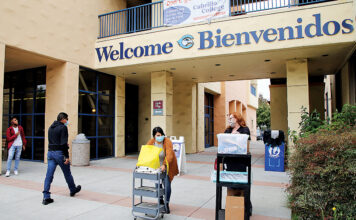Every winter, the people who live and work in the flats of Rio Dell Mar experience flooding in the streets and in their yards. Every winter, news reporters descend on the area to cover the events. This year, one reporter asked me about the history of how this issue came to be.
How far back should we go? Before the Spanish came, an Awaswas tribelet of the native Ohlone people lived near Aptos Creek, in the vicinity of Spreckels Drive. The natives built their villages on high ground to avoid flooding in winter. Aptos Creek met the Monterey Bay as a brackish estuary teaming with flora and fauna. With the coming of the Spanish and their mission system, the native’s village was abandoned. Aptos became a cattle ranch. A 500-foot wharf was built at the base of the bluff on the Seacliff side, but primarily, the estuary remained unchanged.
Later, sugar millionaire, Claus Spreckels, purchased most of the Aptos Rancho, and in 1875, he opened the largest and finest summer resort on the California coast. It was located on Spreckels Drive. The lawn and flower gardens sloped away from the hotel. A clubhouse was built near Treasure Island Drive which included a billiard room, bowling alley, bar, and dance floor. Several barns were built to accommodate horses and buggies. Additionally, some small changing rooms were built up against the bluff on the Seacliff side. Aptos Creek still meandered through the estuary and emptied into the bay on the eastern side.
The hotel closed in 1896. Spreckels’ property continued to be operated as a horse ranch. Spreckels had a fence built across the estuary to keep his horses off the beach and every year the fence had to be rebuilt because of storm damage. The old wharf had nearly disintegrated by that time, a result of storm damage and disuse. Local families continued to visit the beach and the estuary, sometimes paddling canoes in the lagoon that formed behind the beach.
Spreckels died in 1908. The ranch continued to operate until 1922 when Spreckels’ heirs sold it. By 1924, development had begun. Leo Monroe, William Lyon and Larry Miller purchased the lands that would become Rio Del Mar. In May of 1926, the estuary would be changed forever.
The Sunset Grading Company of San Francisco was hired to clear and build up the Aptos beach. Steam shovels, tractors and dynamite changed the contour of the beach. Aptos Creek used to meander around Treasure Island, then onward to Sand Street and Lake Court, before entering the bay on the eastern side of the estuary. A large hill that had occupied the area of today’s Rio Sands Hotel, on both sides of Stephan Road, was used to fill in the estuary. The top and face of the bluff, where Rio Del Mar Boulevard descends to the beach, was shaved off and added to the fill, raising the area approximately seven feet.
By August, Aptos Creek was diverted into the western side of the estuary. The new channel was created initially with a wooden retaining which but was eventually cast in concrete. This created a lake on the Seacliff, or Western side of the area. A small seawall was built along the beach and faced with brick. A short walking pier was built out onto the beach which helped to channel the creek toward the bay. The skeletal remains of this pier still remain. The beach parking lot and the streets were laid out and improved with gravel. The first building in the flats was constructed in 1928 and became a sales office for Rio Del Mar. Today, it is called the Sea Breeze.
By the summer of 1928, the western side of Aptos Creek was contained inside a second retaining wall. A dam was constructed across the creek to create the ‘world’s largest freshwater swimming pool’ and a large bathing pavilion was built on the western side of the creek. The streets were paved in 1929. The destruction of the estuary was complete.
Grand plans lead to big problems. The Aptos Creek watershed drains from the 3,790 foot high, Loma Prieta Mountain, which is only ten miles away as the crow flies. The Valencia Creek watershed also empties into Aptos Creek less than 3,000 feet from the bay. When it rains, all of the water that does not soak into the soil, hurtles down the creeks and is funneled into the narrow channel built by the developers. It quickly fills up. Even if the river does not overflow, the rainwater collecting in the Rio Del Mar flats has nowhere to go. The drains fill up and the streets flood. The drains onto the beach also typically filled with sand. During a major rain event, the river can overflow and create serious problems.
And then there are the tides. So-called, spring tides occur about twice a month when the sun, earth and moon are in alignment. During the winter, we tend to have exceptionally large variations in tides called king tides. High tides may be six feet and low tides might be minus one foot. King tides with large waves sometimes make their way onto the Esplanade and into the streets. As the old saying goes, “a rising tide floats all boats,” but in the Rio Del Mar flats, it also floods all houses.
Help is on the way? Santa Cruz County Public Works wants to help. Plans have been drawn up, test wells have been drilled and all they need is money. Grants have been applied for. The plan is to build a catch basin on Venetian Road near Pixie’s Deli and install a pump to push the water into a new drain system. Mother nature is a formidable force. Let’s hope that this solution will help to relieve the problem.
If you would like to learn more about the history of the estuary and the county’s plans to help the neighborhood, we will entertain you with amazing historical photographs and a presentation by Public Works Director, Matt Machado. Please join us at the Rio Sands Hotel community room on Saturday, January 25th, from 2:30 until 4:00 pm for Coffee, Tea and History, Water, Water Everywhere. Reservations only please as space is limited, 688-1467. $25 general admission, $20 museum members. Donation benefits the Aptos History Museum.











